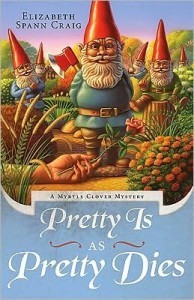Self-Publishing a Series after Its Traditional Start
By Elizabeth S. Craig, @elizabethscraig
My self-published Myrtle Clover series started out as a traditional release through Midnight Ink. They published the first book in that series before deciding against a second book in the series. That’s when I got my rights back (well, the ones that I could get back), and self-published the rest.
Now I’ve got the Southern Quilting mysteries which will be dropped by Penguin after the upcoming June release of book five in the series. I’ve gotten those rights back and will be embarking on the same process soon.
These were good decisions for me and for my series. But there have definitely been some bumps in the road.
Issues I’ve run into:
Bundling. This is currently a migraine-inducing pain in the neck for me. I’ve decided to create a bundle of several Myrtle Clover titles, since I’ve got eight books in the series. Luckily, I’ve written my series so that each book functions as a standalone and with no continuing storyline. But it still sort of stinks that I’ve got to bundle what are basically books 2, 3, and 4. To get around this, I asked the designer not to even put book numbers on the box set cover. We’d just call it Myrtle Clover Bundle Volume I. It’s the best I can do. I wouldn’t attempt this with the Southern Quilting mysteries, not having the rights to books 1-5.
Continuing with a series brand without infringing on cover copyright issues. This wasn’t quite as much of a problem with my Myrtle Clover series since there was only one traditionally published book in the series. It promises to be more of an issue with the Southern Quilting mysteries since there will soon be a 5th traditionally published in that series and I’m continuing with them, as self-published books, starting in 2016.
Readers don’t understand inconsistencies within the series. They email me that Pretty is as Pretty Dies isn’t in an audio book format or that it isn’t available (why, I don’t know) in ebook format at Nook. I just briefly reply that I don’t have the rights to the book. Sometimes they complain about the print price of the title (which is now out of print). I do have the print rights converted to me now, and I probably need to get on the stick with putting it up on CreateSpace. This will likely give their digital format of the title a run for the money…considering my CreateSpace print price and their ebook price will probably be comparable.
Was There a Trad Pub Boost Originally?
Can starting out in trad-pub give your series a boost? The answer is…sometimes. I think it did for my books because my readership is a bit older and they did shop in physical bookstores for their books. I’ve had readers say that they’ve picked up my books at the drugstore or the Books-a-Million, etc. Each day I believe that more readers are trying out e-readers, though.
Whether or not you get a boost from starting a series in trad pub (or are successful in trade publishing at all) depends on a variety of factors. These include publisher marketing efforts, distribution, and the all-important cover.
One accidental benefit to my first Myrtle Clover being traditionally published is that the ebook prices for my other books in the series look like steals next to the trad-pubbed ebook price.
Looking back
I will never regret taking my Myrtle Clover series to self-pub. I’d advise other writers who have their series dropped by traditional publishers to self-publish additional books for their series, whether they have lots of readers or not. My only regret is that my Myrtle Clover series started in trad. publishing, especially since it was only the one book. It’s made things complicated, especially with the bundling/box set issue that I’m working through now.
Any other hybrid writers out there who want to weigh in?
Self-publishing a series that started out as trad-pubbed:
Click To Tweet
The post Self-Publishing a Series after Its Traditional Start appeared first on Elizabeth Spann Craig.



